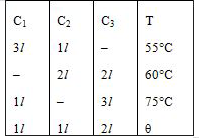The given table shows the freezing points in 0F of different gases at sea level. Convert each of these into 0C to the nearest integral value using the relation and complete the table,.
C=59(F−32)

Step by step video & image solution for The given table shows the freezing points in 0F of different gases at sea level. Convert each of these into 0C to the nearest integral value using the relation and complete the table,. C=(5)/(9) (F-32) by Maths experts to help you in doubts & scoring excellent marks in Class 7 exams.
Updated on:21/07/2023Topper's Solved these Questions
- INTEGERSBOOK - NCERT EXEMPLARCHAPTER - INTEGERSEXERCISE - (D) APPLICATION (Puzzle)
5 Videos
- INTEGERSBOOK - NCERT EXEMPLARCHAPTER - INTEGERSEXERCISE - THINK AND DISCUSS
13 Videos
- INTEGERSBOOK - NCERT EXEMPLARCHAPTER - INTEGERSEXERCISE - VOCOBULARY
5 Videos
- FRACTIONS AND DECIMALSBOOK - NCERT EXEMPLARCHAPTER - FRACTIONS AND DECIMALSEXERCISE - EXERCISE (FIND THE ERROR)
3 Videos
- LINES AND ANGLES BOOK - NCERT EXEMPLARCHAPTER - LINES AND ANGLES EXERCISE - Exercise (fill in the blanks)
3 Videos
Similar Questions
Three containers C1,C2andC3 have water at different temperatures. The table below shows the final temperature T when different amounts water (given in liters) are taken from each container and mixed (assume no loss of heat during the process)

The value of θ (in .∘C to the nearest integer) is ------------
View SolutionThree containers C1,C2 and C3 have water at different temperatures. The table below shows the final temperature T when different amounts of water (given in litres) are taken from each containers and mixed (assume no loss of heat during the process)

The value of (in °C to the nearest integer) is …….
View Solution
Knowledge Check
The table given below show the selling price (in Rs/kg) of 4 different items at 5 different items at 5 different shops.
What is the average selling price (in Rs/kg) of item C? A16.8B15.2C14.6D13.8
A16.8B15.2C14.6D13.8In each equation, there is a table having 3 columns and 4 rows. Based on the table, there are 3 questions. Each question has 4 options (a), (b), (c ) and (d), ONLY ONE of these four options is correct.
There are different types of lasers. In the given table, Colums I shows the properties of different lasers or material used in lasers, Column II shows the different names of the lasers and Column III shows the uses of different type of lasers.

What are the characteristics of liquid state laser?A(III) (i) (K)B(I) (i) (L)C(III) (iv) (M)D(I) (iv) (M)In each equation, there is a table having 3 columns and 4 rows. Based on the table, there are 3 questions. Each question has 4 options (a), (b), (c ) and (d), ONLY ONE of these four options is correct.
There are different types of lasers. In the given table, Colums I shows the properties of different lasers or material used in lasers, Column II shows the different names of the lasers and Column III shows the uses of different type of lasers.

What are the characteristics of solid-state laser?A(III) (ii) (L)B(I) (ii) (L)C(II) (i) (M)D(II) (i) (K)
The table given below shows the marks obtained by six students in 5 different subjects.

Maximum marks for each subject is 100.
What is the aggregate percentage of marks obtained by student C in all the five subjects?
View SolutionThree containers C1,C2andC3 have water at different temperatures. The table below shows the final temperature T when different amounts of water (given in litres) are taken from each containers and mixed (assume no loss of heat during the process)

The value of θ (in ∘C to the nearest integer) is.......
View SolutionIn each equation, there is a table having 3 columns and 4 rows. Based on the table, there are 3 questions. Each question has 4 options (a), (b), (c ) and (d), ONLY ONE of these four options is correct.
There are different types of lasers. In the given table, Colums I shows the properties of different lasers or material used in lasers, Column II shows the different names of the lasers and Column III shows the uses of different type of lasers.

What are the characteristics of semiconductor laser?
View SolutionThe table given below shows the marks obtained by six students in 5 different subjects.

Maximum marks for each subject is 100.
What is the aggregate percentage of marks obtained by student C in all five subjects?
View SolutionThe table given below shows the marks obtained by six students in 5 different subjects.

Maximum marks for each subject is 100.
What is the aggregate percentage of marks obtained by student C in all five subjects?
View Solution
